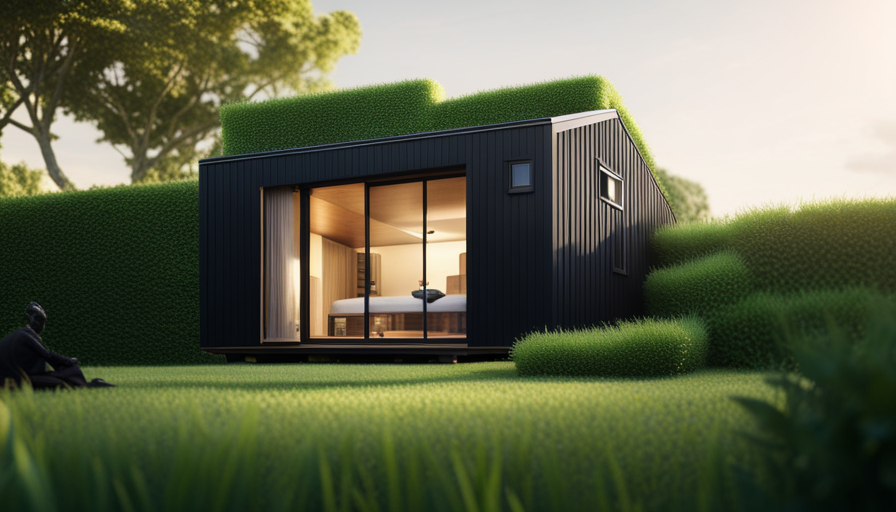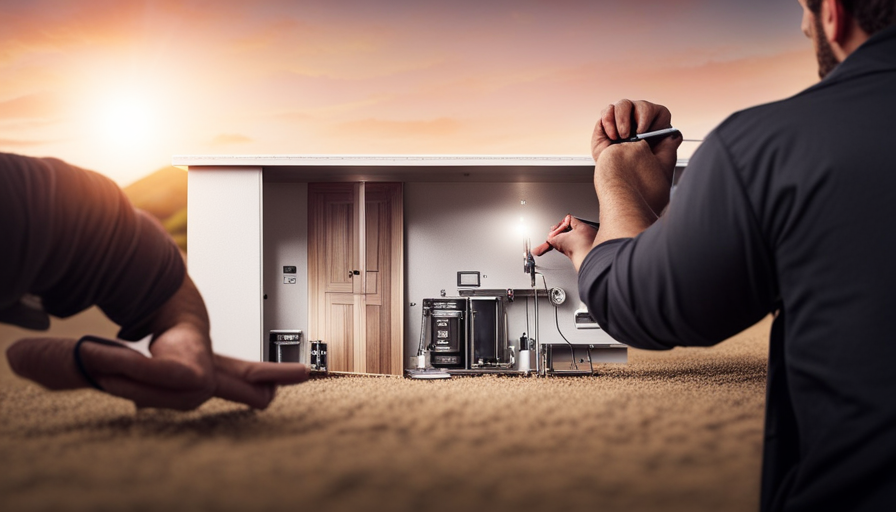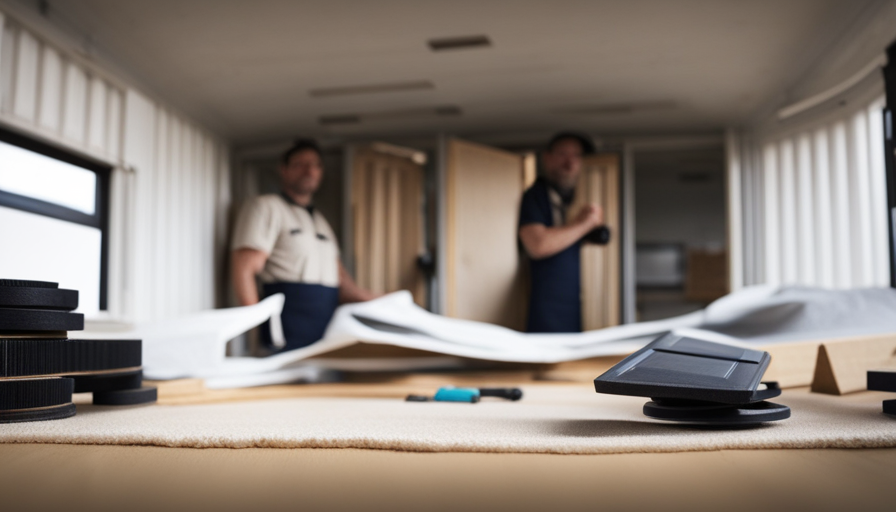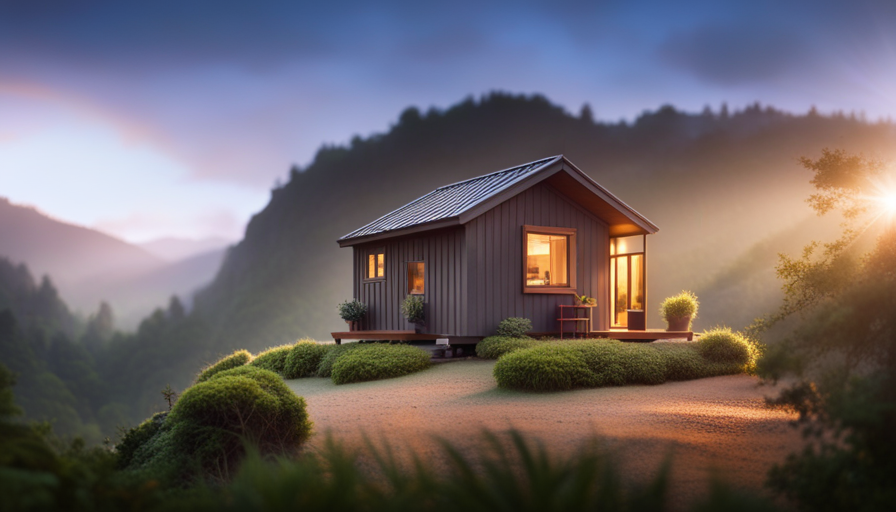Have you ever felt confined within the four walls of your own home? It can feel like there is not enough space to even breathe comfortably, let alone live freely.
Well, you’re not alone. Many people today are seeking alternative housing options that offer a sense of freedom and simplicity. Enter the tiny house and the small house – two contenders in the battle for the perfect compact dwelling. These pint-sized homes may seem similar at first glance, but they have distinct characteristics that set them apart.
In this article, we will explore the differences between tiny houses and small houses, examining factors such as size, cost, design, mobility, sustainability, and lifestyle. By the end, you’ll have a clear understanding of which option suits your needs and desires best.
So, let’s dive into the world of tiny houses and small houses and discover the perfect fit for you.
Key Takeaways
- Tiny houses maximize space and offer clever storage solutions, while small houses may have more square footage but still prioritize efficient use of space.
- Tiny houses are often more cost-effective and environmentally friendly, with lower energy consumption and the potential for high return on investment and rental income.
- Small houses may offer more customization options and space for guests, but tiny houses are more portable and can be easily relocated.
- Both tiny houses and small houses offer a strong sense of community and the opportunity for minimalistic living, but tiny houses may have more restrictions due to zoning regulations.
Size and Space Considerations
As you step inside a tiny house, you’ll immediately feel the coziness of the compact space, with everything within arm’s reach and clever storage solutions maximizing every inch.
Storage solutions are an essential aspect of tiny house living, as they allow for efficient organization and utilization of space. From built-in cabinets and shelves to multi-purpose furniture, every nook and cranny is utilized to its fullest potential.
Furniture placement is another important consideration in a tiny house. The layout must be carefully planned to maximize functionality and create a sense of openness. By strategically placing furniture, such as using folding tables or wall-mounted desks, the space can be transformed to meet various needs throughout the day.
Moving on to the next section on cost and affordability, it is important to consider how these factors impact the decision-making process.
Cost and Affordability
When considering the cost and affordability of a tiny house or small house, there are several key points to take into account.
Firstly, the initial investment and construction costs can vary greatly depending on factors such as location, materials used, and customization options.
Secondly, it’s important to consider the long-term financial implications, such as maintenance and utility expenses, which can differ significantly between these two types of houses.
Lastly, taking into account long-term financial considerations, such as resale value and potential for future expansion or renovations, is crucial in making an informed decision about the cost and affordability of a tiny house or small house.
Initial investment and construction costs
Although the initial investment and construction costs may vary, opting for a tiny house can often result in significant savings compared to a traditional small house. One reason for this is the modular construction method commonly used in tiny houses. With modular construction, the house is built in sections off-site and then assembled on-site. This streamlined process reduces labor and material costs, making the overall construction more affordable.
Additionally, tiny houses offer customization options that can further lower expenses. By carefully selecting materials and finishes, homeowners can control costs while still creating a personalized living space.
As we consider the financial benefits of choosing a tiny house, it is important to also examine the ongoing expenses. Transitioning to the next section about maintenance and utility expenses, it’s crucial to understand the long-term costs associated with tiny house living.
Maintenance and utility expenses
To keep your new compact home in tip-top shape, it’s important to consider the ongoing maintenance and utility costs. Here are three key factors to keep in mind:
- Energy Efficiency: One of the advantages of both tiny and small houses is their ability to minimize energy consumption. With their smaller size, these homes require less energy to heat, cool, and power. By investing in energy-efficient appliances and insulation, you can further reduce your utility expenses.
- Eco-Friendly Materials: Many tiny and small house builders prioritize the use of eco-friendly materials. From reclaimed wood to recycled insulation, these sustainable choices not only contribute to a healthier environment but can also lower maintenance costs in the long run.
- Reduced Maintenance: With fewer square footage to maintain, tiny and small houses generally require less time and money for regular upkeep. Additionally, their compact design often means simpler systems and fewer repairs.
Considering the energy efficiency and eco-friendly materials, maintaining a tiny or small house can be both environmentally and financially sustainable. Looking ahead, let’s discuss the long-term financial considerations without losing sight of these important factors.
Long-term financial considerations
As you plan for the future, it’s crucial to consider the long-term financial implications of living in a compact and sustainable home.
One major advantage of both tiny houses and small houses is the potential for a high return on investment. These types of homes typically require a smaller initial investment compared to traditional houses, and their growing popularity means that they often have a strong resale value.
Additionally, both tiny houses and small houses have the potential for rental income. Many people choose to rent out their compact homes to vacationers or long-term tenants, providing an additional source of income. This can help offset the cost of the home and even turn it into a profitable investment.
Moving forward, it’s important to also consider the design and aesthetic appeal of these homes, as they can greatly influence their marketability and potential for rental income.
Design and Aesthetic Appeal
With its cozy and charming design, a tiny house is like a snug little nest that envelops you in warmth and contentment. The interior design of a tiny house is carefully thought out to maximize every inch of space. Clever storage solutions, multifunctional furniture, and creative layouts create a sense of openness and functionality. The use of natural materials and neutral color palettes adds a touch of elegance to the small space.
Exterior landscaping in a tiny house is equally important, as it extends the living space outdoors. Utilizing vertical gardens, compact patio furniture, and efficient lighting can transform a small outdoor area into a serene oasis.
Transitioning into the next section about mobility and portability, it’s important to note that the design and aesthetic appeal of a tiny house can be maintained even when on the move.
Mobility and Portability
The freedom to take your cozy, charming nest on the road, wherever adventure calls, creates a thrilling sense of possibility and wanderlust. When it comes to mobility and portability, tiny houses have a clear advantage over small houses. Their compact size and lightweight construction make them easier to transport, whether it’s hitching them to a truck or towing them behind a vehicle.
This portability benefits those who crave a nomadic lifestyle or wish to explore different locations without sacrificing the comforts of home. However, mobility does come with its challenges. Maneuvering a tiny house through narrow streets or finding suitable parking spots can be tricky. Additionally, the structural integrity of a tiny house must be carefully considered to withstand the stresses of being constantly on the move.
Transitioning to the subsequent section about sustainability and environmental impact, it is important to explore how these small dwellings can minimize their carbon footprint.
Sustainability and Environmental Impact
Living in a compact abode on wheels can be a greener choice, as it allows individuals to reduce their carbon footprint and take their sustainable lifestyle on the road. Here are four reasons why tiny houses and small houses are more sustainable and environmentally friendly:
- Energy efficiency: These homes are designed to maximize energy efficiency, with features like solar panels, LED lighting, and energy-efficient appliances, reducing the overall energy consumption.
- Renewable materials: Many tiny houses and small houses are built using sustainable and renewable materials such as reclaimed wood, bamboo, and recycled materials, minimizing the environmental impact of construction.
- Reduced waste: With limited space, living in a tiny or small house encourages individuals to adopt a minimalist lifestyle, reducing waste generation and promoting sustainability.
- Off-grid living: Tiny houses can be equipped with systems for collecting rainwater, composting toilets, and alternative energy sources, allowing individuals to live off-grid and reduce their reliance on traditional utilities.
Transitioning into the subsequent section about ‘lifestyle and functional considerations’, it’s important to understand how these sustainable choices also impact our daily lives.
Lifestyle and Functional Considerations
Transitioning into the subsequent section about lifestyle and functional considerations, it’s important to understand how these sustainable choices also impact our daily routines and enhance our overall quality of life. When it comes to tiny houses and small houses, home organization is essential due to limited space. However, this constraint can actually be a positive aspect, as it forces us to declutter and prioritize our belongings. Living in a smaller space encourages a minimalist lifestyle, where we learn to appreciate the things that truly matter. Additionally, community integration is a significant factor to consider. Tiny house communities are popping up, fostering a sense of belonging and creating opportunities for social interaction. Living in a close-knit community allows for shared resources and support, making it easier to transition into a simpler lifestyle. Overall, the lifestyle and functional considerations of tiny houses and small houses can lead to a more organized and connected way of living.
| Pros | Cons |
|---|---|
| Efficient use of space | Limited storage |
| Lower maintenance costs | Less privacy |
| Strong sense of community | Potential zoning restrictions |
| Reduced environmental footprint | Lack of space for guests |
| Opportunity for minimalistic living | Limited customization options |
Frequently Asked Questions
Can I legally live in a tiny house or small house in my area?
In my area, the legality of living in a tiny house or small house depends on local regulations. It’s essential to research and understand the specific rules governing tiny house legality and small house regulations. These guidelines may include minimum square footage requirements, zoning restrictions, and building codes.
By staying informed and adhering to these regulations, I can ensure that I’m living within the legal parameters of my area while enjoying the benefits of a compact and efficient home.
What are the zoning regulations and building codes that I should be aware of when choosing between a tiny house and a small house?
When considering zoning regulations, building codes, legal restrictions, size limitations, insurance considerations, and utility requirements, it’s crucial to understand the specific requirements in your area.
Zoning regulations determine where you can place your house and what it can be used for.
Building codes ensure safety and structural integrity.
Legal restrictions may include minimum square footage requirements.
Insurance considerations involve coverage for tiny houses versus small houses.
Utility requirements include access to water, electricity, and sewage disposal.
Are there any restrictions or limitations on the size or height of a tiny house or small house?
There are building permits required for both tiny houses and small houses, and they can vary depending on your location. These permits typically regulate the size and height of the structure, ensuring it meets safety standards.
Additionally, financing options may be limited for unconventional housing choices like tiny houses. It’s important to research and understand the specific regulations and restrictions in your area before deciding on the size or height of your home.
Are there any specific requirements for utilities such as water, electricity, and sewage for a tiny house or small house?
When it comes to specific requirements for utilities in a house, there are a few key considerations. Water supply requires a connection to a reliable source and may necessitate the use of a water tank or well.
Electricity typically requires a power source, such as a connection to the grid or the use of alternative energy systems.
As for sewage, a proper waste management system is essential, which could involve a septic tank or connection to a municipal sewage system.
What are the insurance considerations for a tiny house or small house, and are there any specific policies or coverage options available for these types of homes?
When it comes to insurance coverage for a home, there are specific considerations for both tiny houses and small houses. Insurance policies for these types of homes can vary depending on factors such as size, location, and construction materials.
Coverage options may include property insurance, liability insurance, and even specialized policies designed specifically for tiny houses. It’s important to work with an insurance provider who understands the unique needs of these homes to ensure adequate coverage.
Conclusion
In conclusion, when it comes to deciding between a tiny house and a small house, it ultimately boils down to personal preferences and priorities.
While tiny houses offer a quaint and eco-friendly living experience, small houses provide a bit more space and functionality.
Both options have their own unique charm and benefits.
Whether you choose to embrace the minimalist lifestyle of a tiny house or opt for the versatility of a small house, it’s important to consider factors like size, cost, design, mobility, and sustainability.
Ultimately, the decision is yours to make based on what suits your needs and desires.
I’m Theodore, and I love tiny houses. In fact, I’m the author of Tiny House 43, a book about tiny houses that are also tree houses. I think they’re magical places where imaginations can run wild and adventures are just waiting to happen.
While tree houses are often associated with childhood, they can be the perfect adult retreat. They offer a cozy space to relax and unwind, surrounded by nature. And since they’re typically built on stilts or raised platforms, they offer stunning views that traditional homes simply can’t match.
If you’re looking for a unique and romantic getaway, a tree house tiny house might just be the perfect option.










